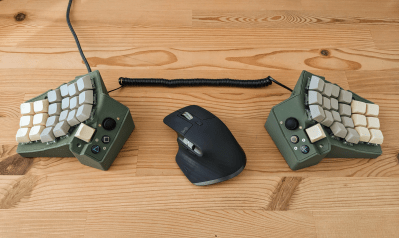Okay, you have to see the gallery to appreciate it, but this keyboard was designed to resemble a red cedar tree with the green shell and wood bottom and the copper PCB showing through the tree cutouts on the sides.

Oh, and are those Nintendo Switch joysticks above the PS2 buttons? Those are for the mouse and vertical/horizontal scrolling. Honestly, this seems like a great amount of thumb controls. The basics are there (presumably), and there isn’t any thumb-extending excess, like keys on the insides by the mouse.
This bad mama jama runs on an RP2040 and has 50 hand-wired Cherry Brown switches plus the PS2 buttons. In the build guide, you can read all about [WesternRedCdar]’s troubles with integrating those. The Nintendo Switch joysticks weren’t terribly easy, either, since the ribbon connector can’t be soldered directly.
The final issue was one of weight. Since many of the switches stand quite tall, it sort of jostles the keyboard to actuate them. [WesternRedCdar] opined that that the ideal solution would have been to use metal base plates instead of wood, but took care of the issue by adding layers of 1/8″ steel flat bar inside the case.
Continue reading “Keebin’ With Kristina: The One With All The Green Keyboards”

















